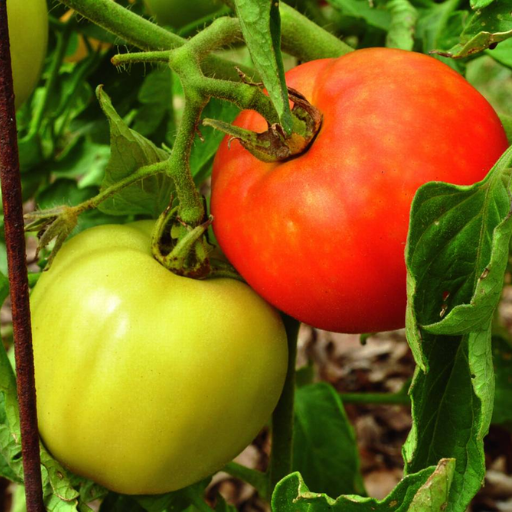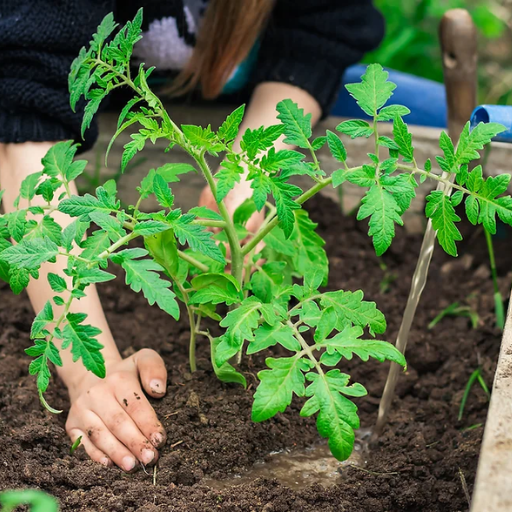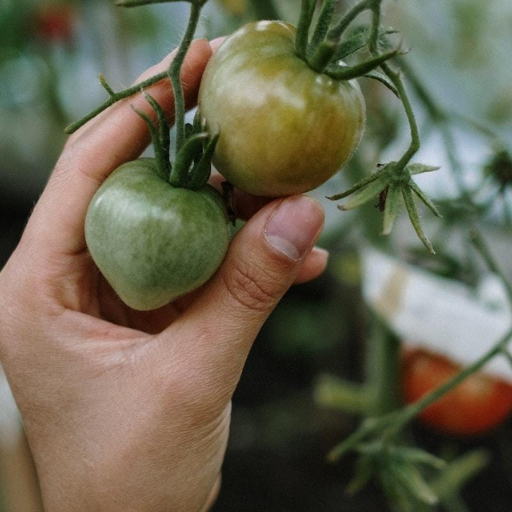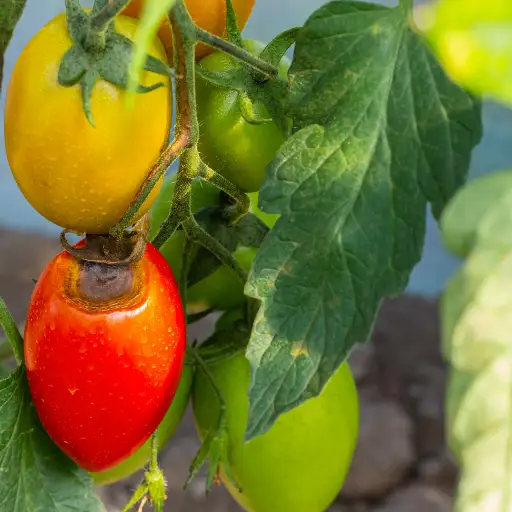Those fond of gardening understand that nurturing flowers and tomatoes is usually a plant choice among home gardeners. However, getting that perfect harvest involving juicy and bright tomatoes might sometimes be demanding. One standard option to increase tomato production is using Epsom Salt, a naturally occurring mineral comprising magnesium and sulfate components. This article explains how to successfully include Epsom salt in your tomato growing routine by discussing its advantages, recommended application methods, and tips for achieving better yields. Whether you are an experienced gardener or not, this post will help you learn about improving the tomato plants and making gardening even more enjoyable.
Why Use Epsom Salt for Tomato Plants?

Please explain how Epsom salt helps tomatoes grow and produce fruits.
Epsom salt has many advantages for the growth and production of tomatoes, primarily because it contains magnesium and sulfate. Below is a summary of how it positively affects tomato cultivation:
- Increased Photosynthesis: Magnesium aids in producing chlorophyll, which is necessary for plants to convert sunlight into energy efficiently. This process is essential for maintaining healthy tomato plants that grow faster and produce more fruits.
- Enhanced Nutrient Uptake: The presence of sulfate enhances the absorption of key elements such as nitrogen or phosphorus required for plant development and fruiting. A balanced supply of nutrients results in robust, healthier plants.
- Fruit Quality: By increasing magnesium levels, Epsom salt can assist in producing firm, tasty tomatoes with better flavors. It also helps alleviate blossom end rot, a common problem in tomatoes caused by calcium deficiency.
- Ideal Soil pH: Epsom salt ensures a suitable soil acidity level, which is crucial for nutrient availability. Tomatoes prefer slightly acidic to neutral soil pH (6.0-7.0).
- Root Development: Plants with more resilient root systems have been observed when magnesium has been incorporated into them, making it useful where there are drought susceptibility cases, reducing general stability; this strength is essential when supporting heavy fruit loads.
Technical Parameters
- Magnesium Concentration: Approximately 10% of magnesium can be found in Epsom salt.
- Target Application Rate: To achieve optimum outputs, use about one tablespoonful per foot at planting time and again during the growing season.
- pH Levels: Keep your soil’s pH within a range of 6.0–7.0, recommended for best nutrient uptake.
The integration of Epsom salt into your tomato-growing regimen will greatly enhance your plants’ health status as well as their growth rates, making you harvest plenty of high-quality yields from your farm than ever before
Can I use Epsom salts to prevent blossom end rot?
Yes, Epsom salts can prevent blossom end rot. As I learned from various gardening resources, such as leading horticultural websites on the internet, the magnesium element of Epsom salt plays a pivotal role in enhancing plants’ calcium absorption. Since this condition is mainly caused by insufficient calcium, adding Epsom salt to the soil provides enough magnesium to support strong and healthy tomatoes. Additionally, encouraging vigorous root development and maintaining appropriate soil pH ensures a favorable environment for nutrient uptake, reducing the chances of blossom end rot. This could be an excellent way for gardeners to protect their tomatoes since they can include Epsom salt in their care routine.
How to Apply Epsom Salt to Tomato Plants

How much Epsom salt should I use on tomatoes?
From my online gardening research, I suggest applying roughly one tablespoon of Epsom salt for every foot of plant height. Here, the application can be made during planting and when the plants are growing to ensure that magnesium is maintained at optimum levels. In addition, some sources say that mixing Epsom salt with water can make an excellent foliar spray when applied directly to leaves at about one tablespoon per gallon.
How does one mix Epsom salt with water for use?
To prepare Epsom salt for use in water, I follow a simple method from prominent gardening websites. First, I take one tablespoon of Epsom salts per gallon of water, ensuring one gets enough quantity to produce a fine mist. I blend these salts in warm water to ensure complete dissolution before adding them to the whole gallon of water. It’s easy if this mixture goes into a spray bottle for later use in the field. When I spray grape vine leaves with this solution, I use either morning or evening hours to avoid sunburns on leaves. Therefore, this foliar spraying must be done every 4-6 weeks throughout the growing season. It helps maintain adequate magnesium levels, which is vital to plant health and preventing diseases like blossom end rot.
Should you put Epsom Salt directly into the soil or use it as a foliage spray?
Both methods have advantages based on my experience and reviews from top gardening websites. Still, I prefer combining them all since they yield better results in terms of yield when compared to each other alone. When using manures mixed with the soil while transplanting tomatoes, I usually add about two tablespoons of Epson Salt per plant, which helps release sulfur and magnesium slowly through the root zone, thus promoting healthier growth.
This enables instant absorption by leaves; therefore, if symptoms indicate a low level of magnesium, then this would be the best solution to apply. With this focused approach, I have managed to save many plants from dying. Finally, which option between soil application and foliar spray to choose will depend on the particular needs of your crop. Still, I find that using both methods produces more muscular and healthier tomato plants throughout the growing season.
When to Use Epsom Salt for Tomato Plants

Should Epsom salt be used during the growing season or at planting?
Leading gardening websites concur that using Epsom Salt when planting and throughout the growing season is generally good because each application has different functions.
- At Planting: At this stage, adding Epsom salt provides a strong foundation of nutrients in the plants, aiding root development and promoting growth. For example, according to Gardening Know How, adding 1-2 tablespoons of Epsom salt to the soil while transplanting will provide essential magnesium and sulfur for developing healthy roots and leaves.
- During Growing Season: Adding more epsom salts later in the season can also be helpful. According to The Old Farmer’s Almanac, top dressing plants with one tablespoon per foot of plant height every month help remedy deficiencies such as yellow leaves or poor fruit bearing. Foliar sprays can also help when there is a sudden need for nutrient uptake at least once every four to six weeks.
- Technical Justification: Chlorophyll production for photosynthesis requires magnesium, while sulfur supports general plant metabolism. Exact ratios may vary, but having balanced magnesium levels in your soil can prevent problems like blossom end rot in tomatoes.
In conclusion, using Epsom Salt at planting and throughout the growing period gives us an all-round strategy for effectively nurturing our tomato plants.
How often should you apply Epsom salt on tomato plants?
I do one monthly application for my tomato plants when they are growing by putting some Epsom salt into them. One tablespoon per foot of plant height allows me to address any nutritional inadequacies promptly. Whenever I detect signs such as yellowing leaves that indicate stress due to lack of nutrients, I spray them with foliar every four to six weeks so they can pick up quickly on missing micronutrients. I can promote healthy growth and fruit production all season long if I monitor my plants consistently and change my application schedule accordingly.
Can epsom salt be used for seedlings as well as mature plants?
Of course, both seedlings and adult ones can have Epsom Salt. My use of Epsom salt starts when planting the transplants to ensure they have enough magnesium and sulfur for their early days. One teaspoon per gallon of watering solution in a gallon is ideal for seedlings’ root health and leaf greening purposes.
For grownup crops, I religiously apply using 1 tablespoon per foot of plant height once a month throughout the year. The scientific basis of these applications revolves around the importance of magnesium in chlorophyll synthesis and general plant metabolism. Furthermore, applying Epsom Salts helps prevent common issues such as blossom end rot, which arise from an imbalance between various nutrient levels, especially calcium plus magnesium. Maintaining these balanced levels supports plant health and maximizes fruit yield.
Understanding Soil and Nutrient Requirements for Tomato Plants

Why is soil testing important before applying Epsom salt?
For some reason, a soil test is necessary before using Epsom salt. Firstly, it will tell me about the current nutrient levels and pH of the soil so that I can find out if my plants’ requirements of magnesium and sulfur are already met. For instance, adding Epsom salts may lead to nutrient imbalances where the soil test shows enough magnesium levels. Understanding the calcium content by understanding what blossom end rot is is crucial. That means Epsom salt will serve two roles: supply magnesium and interact with calcium availability, thus minimizing diseases. Ideally, a healthy average pH level should be between 6 and 7 for an average healthy ordinary soil with magnesium levels ranging from 50-150 ppm.Meaning by this means that whenever I make any amendments, such as applying Epsom salts to my plants, there must be some benefit, or even go ahead to justify its use based on specific technical parameters derived from the soil analysis to promote plant growth and fruit set.
Which other vital nutrients do tomato plants need?
Apart from magnesium, there are several other essential nutrients that I have found helpful in growing tomatoes successfully. Nitrogen is needed for leaf growth, while phosphorus enables root system establishment, thus leading to fruit production. Potassium also plays a significant role in the general health of my plants; it helps them store water efficiently, thereby enhancing disease resistance. Calcium also has a role since, during cell wall development, chances are that blossom ends rots will not occur when it works well with magnesium. Lastly, minors such as iron, manganese, and zinc should be present at low concentrations because they improve biochemical reactions, thus increasing my tomato crops’ overall productivity and resilience. Placing these primary nutrients into good balance within my soils will produce more robust vines with many fruits.
How does soil pH affect nutrient uptake in tomatoes?
Soil pH has a lot of bearing on the nutrient uptake by my tomato plants. This balance ensures that the roots absorb essential nutrients efficiently, as I aim at an ideal pH range of 6.0-7.0. There are cases where certain nutrients can get reduced if the pH is too low (acidic) or too high (alkaline). For example, acidic soils may retain calcium and magnesium, while high pH levels may hinder the availability of iron, manganese, and zinc, vital in preventing diseases. Thus, through regular soil testing and adjustment for pH, I will be able to secure a wholesome package of nutrients my tomatoes require for growth and fruiting purposes.
Potential Risks of Using Epsom Salt on Tomato Plants

Can the excessive use of Epsom salt harm tomato plants?
Certainly, overuse of Epsom salt can damage tomato plants by creating an imbalance in nutrient levels, which may have toxic effects. This is what reputable gardening sites say:
- Uneven Nutrient mix: The main components of Epsom salts are magnesium and sulfate. Excessive quantities of magnesium might cause symptoms of deficiency in other essential minerals, such as calcium and potassium. Cell wall structure depends on calcium, and plant health overall relies on potassium. Optimum ratios for magnesium to calcium should be around 1:4 so that no problems arise.
- Accumulation of Salts: If Epsom salt is used frequently, salt might accumulate in the soil. This may lead to osmotic stress on the crops, as plants will exhibit signs such as leaf burn, wilting, and stunted growth due to salt build-up.
- Recommended Usage: Many experts suggest using approximately one or two tablespoons per gallon of water once every month as a general guideline for application during the growing season. Anything above can produce adverse outcomes, especially with soils already abundant in magnesium.
By overseeing my soil’s nutrient status and applying Epsom salts judiciously, I can minimize my risks while helping my tomatoes.
What are some symptoms showing that plants have too much magnesium?
There are several things I watch for when I notice my plants have too much magnesium (Mg). The most typical symptom is yellowing leaves between their veins, known as interveinal chlorosis. Leaves may be twisted or curled due to Mg toxicity, declining vigor, and slower growth throughout the plant body. Brown or necrotic spots appear on leaves if this issue worsens, whereas fruit production could also reduce, specifically among tomatoes I grow at home. Therefore, reducing Mg incorporation sources into soils and needful Ca or K additions would relieve these symptoms.
Are there other ways to provide tomatoes with magnesium?
Yes, there are several other ways through which I can give my tomato plants magnesium. The best way for me is dolomitic lime, which adds Mg and raises soil pH if necessary. Usually, I put around 2-5 pounds per 100 square feet, depending on what my soil test recommends. Another option is mixing in Epsom salts (magnesium sulfate) and adding 1-2 tablespoons when planting each plant. Additionally, compost or organic fertilizers containing Mg, such as some bone meals, could enrich the soil while slowly releasing nutrients. Every one of these options enables me to effectively deal with magnesium deficiency without the risks associated with over-application
Reference sources
Frequently Asked Questions (FAQs)

Q: What are the benefits of using Epsom salt for tomato plants?
A: Epsom salt is good for tomato plants as it provides magnesium sulfate, essential for plant growth. It helps improve flower production, increases nutrient uptake, and prevents blossom-end rot caused by magnesium deficiency.
Q: How much Epsom salt should I use for tomato plants?
A: Many gardeners recommend using one tablespoon of Epsom salt per foot of plant height. You can dilute it in water and put it directly onto the soil around your tomato plants.
Q: How often should I apply Epsom salt to my garden?
A: The frequency of Epsom salt application depends on the specific needs of your garden. Generally, it can be applied every two to four weeks during the growing season.
Q: Can Epsom salt be used for both peppers and tomatoes?
A: Yes, epsom salt can improve the growth of peppers and tomatoes by providing magnesium, which is crucial for these plants. The addition of epsom salt to the soil benefits both tomatoes and peppers.
Q: How should I prepare an Epsom salt solution for my vegetable garden?
A: To prepare an Epsom salt solution, dilute one tablespoon of Epsom salt in a gallon of water. This solution can be sprayed directly onto the leaves or poured around the base of the plants.
Q: Is Epsom salt necessary if I have a soil test kit?
A: A soil test kit can help determine if your garden soil is deficient in magnesium. If the test shows a deficiency, adding Epsom salt may benefit your plants.
Q: Can too much Epsom salt harm my tomato plants?
A: While Epsom salt is beneficial, using too much can lead to a buildup of magnesium in the soil, which may cause nutrient imbalances. It’s essential to follow the recommended guidelines for application.
Q: How do I know if my tomato plants need Epsom salt?
A: Signs that your tomato plants need Epsom salt include yellowing leaves, poor fruit set, and blossom-end rot. Conducting a soil test can also help determine if magnesium supplementation is necessary.
Q: Can I use Epsom salt when planting tomatoes?
A: You can add Epsom salt to the planting hole when planting tomatoes. Mixing one tablespoon of Epsom salt with the soil at the bottom of the hole helps to provide a good magnesium source for the new plants.
Q: What should I do if Epsom salt isn’t improving my plant’s health?
A: If Epsom salt isn’t improving your plant’s health, it might be due to other nutrient deficiencies or poor growing conditions. Conduct a soil test and ensure you’re providing adequate water, sunlight, and proper care for your plants.







